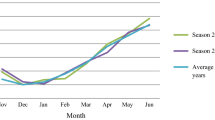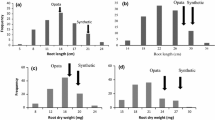Abstract
A Double Haploid (DH) population, 116 plants, derived from the cross between Japonica upland rice IRAT109 and paddy rice Yuefu, planted in PVC pipe under upland ecosystem in 2001 and 2002, was used in this study. Seven root traits, including basal root thickness (BRT), total root number (RN), maximum root length (MRL), root fresh weight (RFW), root dry weight (RDW), ratio of root fresh weight to shoot fresh weight (RFW/SFW) and ratio of root dry weight to shoot dry weight (RDW/SDW), were studied. Using index of drought resistance (IDR), the ratio of yield under upland ecosystem to yield under lowland ecosystem of DH lines, as the criteria of drought resistance, and correlation analysis between root traits and IDR, showed that BRT, MRL and RN were significantly correlated with IDR. High IDR lines had thicker BRT, longer MRL and less RN than low IDR lines. A molecular linkage map with 94 RFLP markers and 71 SSR markers covering 1535.1 cM was produced. QTLs and GxE interactions for BRT, RN, MRL, RFW, RDW, RFW/SFW and RDW/SDW were obtained based on the constructed molecular linkage map and software QTLmapper version 1.0. A total of 18 additive QTLs and 18 pairs of epistatic QTLs associated with root traits were detected. There were nine additive QTLs and two pairs of epistatic QTLs performed significant interactions with environment. Some QTLs with high general contribution and no GxE interaction were obtained. Two pairs of epistatic QTLsmrl3 andmrl8, brt3 andbrtlla controlling MRL and BRT had high general contributions of 21.51% and 13.03% respectively. An additive QTL and a pair of epistatic QTLs controlling RFW and RDW had high general contributions of 13.50% and 25.64% respectively. Marker assisted selection (MAS) for rice drought resistance based on QTL with high general contribution, low GxE interaction and tightly linkage with IDR were also discussed.
Similar content being viewed by others
References
Maclean, J. L., Dawe, D. C., Hardy, B. et al., Rice Almanac. 3rd ed., Los Banos (Philippines): International Rice Research Institute, Bouake (Cote d’Ivoire): West Africa Rice Development Association, Cali (Colombia): International Center for Tropical Agriculture, Rome (Italy): Food and Agriculture Orgnization, 2002, 1–10.
Wade, L. J., Critical characteristics of rainfed rice environments and implications for rice improvement, Genetic Improvement of Rice for Water-limited Environments, (eds. Ito, O., O’Toole, J., Handy, B.) Los Banos (Philippines): International Rice Research Institute, 1999, 1–10.
Wang, H. Q., Bouman, B. A. M., Zhao, D. L. et al., Aerobic rice in northern China: opportunities and challenges, (eds. Bouman, B. A. M., Hengsdijk, H., Handy, B. et al.) Water-wise Rice Production, Los Banos (Philippines): International Rice Research Institute, 2002, 143–154.
Xu, F. X., Zheng, J. K., Zhu, Y. C. et al., Relationship between rooting ability and drought resistance at full-heading in mid-season hybrids rice, Acta Agronomica Sinica (in Chinese), 2003, 29(2): 188–193.
Nguyen, H. T., Babu, R. C., Blum, A., Breeding for drought resistance in rice: Physiology and molecular genetics consideration, Crop Science, 1997, 37: 1426–1434.
Ling, Z. M., Li, Z. C., Yu, R. et al., Agronomic root characters of upland rice and paddy rice (Oryza sativa L.), Journal of China Agricultural University (in Chinese), 2002, 7(3): 7–11.
Zhang, J., Zheng, H. G., Aarti, A. et al., Locating genomic regions associated with components of drought resistance in rice: Comparative mapping within and across species, Theor. Appl. Genet., 2001, 103: 19–29.
Ray, J. D., Yu, L., McCouch, S. R. et al., Mapping quantitative trait loci associated with root penetration ability in rice (oryza sativa L.), Theor. Appl. Genet., 1996, 92: 627–636.
Champoux, M. C., Wang, G., Sarkarung, S. et al., Locating genes associated with root morphology and drought avoidance in rice via linkage to molecular markers, Theor. Appl. Genet., 1995, 90: 969–981.
Kamoshita, A., Zhang, J. X., Siopongco, J. et al., Effect of phenotyping environment on identification of quantitative trait loci for rice root morphology under anaerobic conditions, Crop Science, 2002, 42: 255–265.
Price, A. H., Tomos, A. D., Genetic dissection of root growth in rice (oryza sativa L.), Part II: Mapping quantitative trait loci using molecular markers, Theor. Appl. Genet, 1997, 95: 143–152.
Ali, M. L., Pathan, M. S., Zhang, J. et al., Mapping QTLs for root traits in a recombinant inbred population from twoIndica ecotypes in rice, Theor. Appl. Genet., 2000, 101: 756–766.
Rogers, O. S., Bendich, A. J., Extraction of DNA from plant tissue, Plant Molecular Biology Manual, 1988, A6: 1–10.
McCouch, S. R., Kochert, G., Yu, Z. H. et al., Molecular mapping of rice chromosomes, Thero. Appl. Genet., 1988, 76: 815–829.
Temnykh, S., Park, W. D., Ayres, N. et al., Mapping and genome organization of microsatellite sequences in rice (Oryza sativa L.), Thero. Appl. Genet, 2000, 100: 697–712.
Lander, E. S., Green, P., Abraham, S. J. et al., Mapmaker: An interactive computer package for constructing primary genetic linkage maps of experimental and natural populations, Genomics, 1987, 1: 174–181.
Lincoln, S. E., Daly, M. J., Lander, E. S., Constructing genetic linkage maps with MAPMAKER/EXP version3.0: A tutorial and reference manual, A Whitehead Institute for Biomedical Research Technical Report, 3rd ed., Cambridge (Mass.) Whitehead Institute, 1993.
Wang, D. L., Zhu, J., Li, Z. K. et al., A computer software for mapping Quantitative Trait Loci with main effects, epistatic effects and QTLx Environment interactions, User Manual for QTL Mapper Version l.0, 1999, 1–57.
Zhu, J., Mixed model approaches for mapping quantitative trait loci, Hereditas (Beijing), 1998, 20 (Sup.): 137–138.
Hirasava, T., Physiological characterization of the rice plant for tolerance of water deficit, Genetic Improvement of Rice for Water-Limited Environments (eds. Ito, O., O’Toole, J., Handy, B.), Los Banos (Philippines): International Rice Research Institute, 1999, 89–98.
Zhu, J., Analysis Approaches for Genetic Models (in Chinese), Beijing: China Agricultural Press, 1997, 88–97.
Author information
Authors and Affiliations
Corresponding author
About this article
Cite this article
Mu, P., Li, Z., Li, C. et al. QTL mapping of the root traits and their correlation analysis with drought resistance using DH lines from paddy and upland rice cross. Chin. Sci. Bull. 48, 2718–2724 (2003). https://doi.org/10.1007/BF02901763
Received:
Accepted:
Issue Date:
DOI: https://doi.org/10.1007/BF02901763




